Intro to Knitting Workshop: Materials
So you’ve been on TikTok lately and you’re seeing kickass sweaters made by people who are so aesthetic it hurts. You wonder, “How can I get a wardrobe that is reflective of my inner kawaii - cottage core - kitchen witch?” Well, welcome to the party bb, this is my intro to knitting workshop! In this series I’m going to teach you everything you need to know to start knitting your own items. So flaunt that amazing style of yours and let’s go!
Flaunt your amazing style!
Today’s topic is materials.
Okay, so before we start, take a deep breath with me. In through the nose and out through the mouth. Knitting materials can be overwhelming. There are lots of tools out there, all with the world’s weirdest names like Darning Egg and Niddy Noddy. But let’s hold hands and I’ll walk you through the tools necessary to begin creating knit stuff.
Soon your stash will look like this too!
So, really the only things you need to get started are a pair of knitting needles and some yarn. But there’s a catch. What kind of needles do you need and what type of yarn? Yes, there are different types of yarn, and I don’t just mean fiber content. Yarn comes in different thicknesses, or “weights.” So let’s start with needles because they’re the simpler knitting implement to pick out.
Knitting needles come in set sizes. In the rest of the world, the metric system is used to describe the diameter of a knitting needle in millimeters (except in the UK where it’s the US system in reverse). In the US, where everything is backwards and we refuse to use a measurement system that makes sense, the needles are labeled in (mostly) whole number sizes. The system starts at US 0, the smallest in a standard set, and gets progressively larger up to a size US 15. This is just the sizing for a standard set, and there are bigger and smaller needles available. For our purposes I suggest picking up a pair of US size 8 knitting needles.
A project is born.
Now, when you think of knitting needles you probably think of your grandmother’s straight needles. Two long straight sticks that she could have used to hunt down Dracula himself. Those kinds of needles are generally no longer used by the majority of knitters. Instead, something called circular needles are used. Circular knitting needles are two needles connected by a flexible cord. These are readily available at any craft store, but I highly suggest looking for a local yarn store to get your supplies. Not only will you be supporting a local business, but they’ll have plenty of expertise to help you gather your first supplies or troubleshoot your first project. As stated earlier, I recommend a pair of US size 8 needles. Just to add to the confusion, circular needles’ cords come in different lengths. I suggest a 16inch cord.
A pair of circular needles is great for getting started!
Now that we’ve gathered the needles, let us venture forth into yarn! So, yarn is seriously a whole thing. It comes in a billion fiber contents and gauges, or “weights.” Let’s talk about where to get yarn first. I, again, highly urge you to get your yarn from a local yarn shop or independent vendor. You can, of course, go to a local big box craft store, however their selection is abysmal and the type of yarn they carry is often bad for the environment. The big box stores usually only carry acrylic and acrylic blend yarns. Acrylic is a plastic material, making this yarn plastic. It cannot be recycled in the traditional sense and will spend forever NOT rotting in a landfill. Not to mention the microplastics that we breathe, ingest, and send out into the environment when we wash acrylic garments. I do not endorse the use of acrylic yarn except in the cases of things like budget constraint or wool allergy.
Always check your local yarn shop (LYS) for yarn and tools.
Wool is natural, breathable, and takes only a (necessary) haircut for a sheep or other wool producing animal. No animals are harmed during this haircut and they can better regulate their body temperatures when not laden with heavy wool. The big box stores sometimes also carry cotton in small quantities. They generally carry worsted weight yarn or chunkier. (Worsted = number 4 yarn or “medium thickness”) For our purposes, Worsted weight yarn is what we’re looking for. Pick any color of yarn you’d like to work with. I carry many interesting colors in my shop and they’re all looking for a good home! You can check out my yarn colorways here!
Time for a trim!
With all the materials gathered we are ready to get into the actual knitting process. In my next blog we will cover how to begin your project and the different methods of knitting. I hope this series has been informative so far and, as always, if you have any questions or feedback, feel free to leave them in the comment section below. I’d love to hear from you!
Love and Badassery,
Laura







